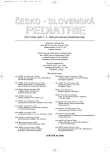-
Medical journals
- Career
Gastroesophageal Reflux in Children with Bronchial Asthma
Authors: A. Tarhini 1; V. Pohanka 2; I. Čierna 1; L. Kovács 1; A. Kapellerová 1
Authors‘ workplace: 2. Detská klinika LFUK a DFNsP, Bratislava prednosta prof. MUDr. L. Kovács, DrSc., MPH 1; Šrobárov ústav detskej TaRCH, Dolný Smokovec riaditeľ doc. MUDr. V. Pohanka, PhD, FCCD, MPH 2
Published in: Čes-slov Pediat 2006; 61 (12): 679-683.
Category: Original Papers
Overview
Background:
Gastroesophageal reflux (GER) plays a role in inducing or exacerbating asthma. GER can induce bronchoconstriction by two pathophysiological mechanisms, specifically the reflex and reflux mechanisms.Objective:
The objective of this study was to test 1) the prevalence of GER in a group of children with asthma, 2) diversity in prevalence of GER between allergic and non-allergic i.e. stable and unstable asthmatic patients, 3) the efficacy of anti-reflux therapy in asthmatics with GER and 4) differences in the efficacy of treatment of allergic and non-allergic patients.Methods:
The authors evaluated 24 hr esophageal pH monitoring in 116 children (65 boys and 51 girls), aged from 6 to 18 years (median age 10.7 years) and hospitalized in Srobarov institute in the second half year of 2004. Medical history data were collected for each patient and included: 1) presence if any of allergic indicators (asthma of parents, allergy and peripheral blood eosinophils of patients) and 2) stability of regularly treated asthma (presence of diurnal and nocturnal respiratory symptoms). They evaluated asthma outcome before and after anti-GER treatment (lifestyle changes, physiotherapy, dopamine antagonist and antacid therapy for six months).Results:
The incidence of GER was 59%, it was significant higher in unstable (70%) then in stable asthma (p <0.001). Between allergic (52%) and non - allergic (65%) asthma was no significant difference in the prevalence of GER. Anti-reflux therapy was effective in improving clinical status (p <0.001), pulmonary functions (p <0.001) and improving of GER (p <0.001). Statistically significant differences in improvement were found between non-allergic (p <0.001; 0.001; 0.001, respectively) and allergic (p <0.05; 0.05; 0.01 respectively) asthma, while in non-allergic asthma the improvement was higher (p <0.01).Conclusions:
The incidence of GER was higher in children with unstable asthma, there were no differences in incidence between allergic and non-allergic types of asthma. Anti-reflux therapy was effective in improving asthma symptoms, pulmonary functions and GER, especially in patients with non-allergic asthma.Key words:
gastroesophageal reflux (GER), bronchial asthma
Labels
Neonatology Paediatrics General practitioner for children and adolescents
Article was published inCzech-Slovak Pediatrics

2006 Issue 12-
All articles in this issue
- Problems in the Diagnostics of Cystic Fibrosis – the Need of Newborn Screening
- Segmental Neurofibromatosis von Recklinghausen
- Gastroesophageal Reflux in Children with Bronchial Asthma
- Collaboration between Children Dentist (Stomatologist) and Anesthesiologist in the Care of Children in General Anesthesia
- Hospitalization of Accompanying Persons at Children Wards
- An Old Tea Pot as the Cause of Severe Lead Poisoning in a 10-year Old Girl
- Molecular Mechanisms of Resistance to Glucocorticoids
- Czech-Slovak Pediatrics
- Journal archive
- Current issue
- Online only
- About the journal
Most read in this issue- Segmental Neurofibromatosis von Recklinghausen
- Gastroesophageal Reflux in Children with Bronchial Asthma
- Collaboration between Children Dentist (Stomatologist) and Anesthesiologist in the Care of Children in General Anesthesia
- Problems in the Diagnostics of Cystic Fibrosis – the Need of Newborn Screening
Login#ADS_BOTTOM_SCRIPTS#Forgotten passwordEnter the email address that you registered with. We will send you instructions on how to set a new password.
- Career

